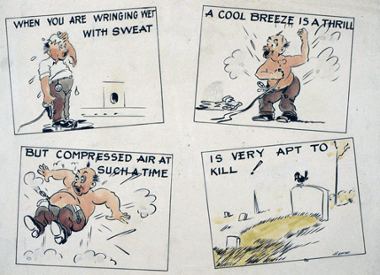7 Tips for Compressed Air Safety
All types of manufacturing processes use compressed air. In fact, every process and machine found in an industrial environment use some form of pressurized air or gas. Unfortunately, because it is so commonplace, people fail to recognize it as the potential hazard that it is. As little as 12 PSI can be deadly in the wrong circumstances, and a small slip up can lead to big problems.
Compressed Air Safety Tips

A variety of tasks requires the use of compressed air including pneumatics, air brakes, refrigeration equipment, breathing equipment, and inflation devices. The intense pressure inside of the canisters means that they pose a potential risk even when they are stationary and not in use. A leak can lead to equipment failure and a puncture can even lead to an explosion. Of course, these are worst case scenarios. However, knowing the risks is the first step towards ensuring compressed air safety.
Some of the risks of high-pressure air are obvious, some less so. Common risks include.
- Foreign objects getting lodged under the skin or flying particles cutting or bruising the body.
- Foreign particles are blown into eyes or eye injuries that can cause loss of sight.
- The injection of an air bubble into the blood stream that can lead to a fatal embolism.
- Air blown into the mouth that can rupture the esophagus or the lungs. (takes only 5 PSI)
- Loud sounds from an air hose can lead to hearing loss or damage. (Sounds can reach 120-130 dB. Well above OSHA’s 90 dB permissible exposure limit.) Taking the relevant safety precautions should protect you from any hearing loss or damage.
Compressed Air Safety Caution
Furthermore, knowing the risks of pressurized air or gas is the first step towards ensuring job site and workplace safety. See the list below for 3 “Nevers” and 4 “Always” rules of the compressed air.
- NEVER POINT IT AT YOURSELF OR ANOTHER PERSON! Absolutely no horseplay. It only takes 12 PSI to blow an eye out of its socket, and 40 PSI can blow out an ear drum from 4 inches away. Air moves faster than you do, don’t let a fatal accident happen by trying to be funny.
- NEVER USE IT TO CLEAN CLOTHING OR HAIR! Don’t use it to “dust” yourself off. See the risks above.
- NEVER USE IT TO CLEAN WORKSPACES OR EQUIPMENT UNLESS NECESSARY! If you must clean the workspace or equipment with compressed air, do not use air set above 30 PSI. 30 PSI is sufficient for removing dirt and debris, any higher can be a threat to workplace safety.
- ALWAYS FOLLOW PRESSURE RATINGS AND LIMITATIONS! Filling automotive tires with air can result in an explosion. Pay close attention to the pressure ratings and limitations and always use a gauge to check tire pressure. Hoses and lines are rated for maximum operating pressure too. Check the limitations of equipment before use.
- ALWAYS CHECK THE CONDITION OF HOSES AND LINES BEFORE USE! Holes, tears or damaged nozzles can lead to leaks or clogs. These issues can lead to turning the pressure up to an unsafe level to attempt to compensate. Avoid this at all costs. Make sure all equipment is working correctly before use.
- ALWAYS WEAR PROPER PPE! This includes everything from safety glasses w/ side shields, full-face shields, face masks, hearing protection, and sometimes even respiratory protection.
- ALWAYS WEAR PROPER PROTECTIVE CLOTHING. Normal work clothing is not sufficient protection against pressurized air.
Moffitt & Compressed Air
The entire Moffitt team, including ventilation design, manufacturing, and installation, is educated on the hazards of compressed air. Our employees are taught to exercise caution around any type of pressurized gas in the factory, on the job site, and even at home. When manufacturing industrial ventilation equipment, like the MatrixVent, we take care with any and all types of compressed gases.
To learn more about compressed air safety visit the website for the Compressed Gas Association. Also, keep up with the Moffitt blog for more workplace safety tips.
